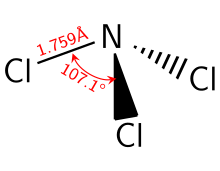| Properties | |
|---|---|
| NCl3 | |
| Molar mass | 120.36 g·mol−1 |
| Appearance | yellow oily liquid |
| Odor | chlorine-like |
| Density | 1.653 g/mL |
| Melting point | −40 °C (−40 °F; 233 K) |
| Boiling point | 71 °C (160 °F; 344 K) |
| immiscible slowly decomposes | |
| Solubility | soluble in benzene, chloroform, CCl4, CS2, PCl3 |
| Structure | |
| orthorhombic (below −40 °C) | |
| trigonal pyramidal | |
| 0.6 D | |
| Thermochemistry | |
Std enthalpy of
formation (ΔfH⦵298) |
232 kJ/mol |
| Hazards | |
| NFPA 704 (fire diamond) | |
| 93 °C (199 °F; 366 K) | |
| Related compounds | |
Other anions
|
Nitrogen trifluoride Nitrogen tribromide Nitrogen triiodide |
Other cations
|
Phosphorus trichloride Arsenic trichloride |
Related chloramines
|
Monochloramine Dichloramine |
Related compounds
|
Nitrosyl chloride |
Nitrogen trichloride, also known as trichloramine, is the chemical compound with the formula NCl3. This yellow, oily, and explosive liquid is most commonly encountered as a product of chemical reactions between ammonia-derivatives and chlorine (for example, in swimming pools). Alongside monochloramine and dichloramine, trichloramine is responsible for the distinctive 'chlorine smell' associated with swimming pools, where the compound is readily formed as a product from hypochlorous acid reacting with ammonia and other nitrogenous substances in the water, such as urea from urine.
Preparation and structure
The compound is prepared by treatment of ammonium salts, such as sal ammoniac with a chlorine source.
Intermediates in this conversion include monochloramine and dichloramine, NH2Cl and NHCl2, respectively.
Like ammonia, NCl3 is a pyramidal molecule. The N-Cl distances are 1.76 Å, and the Cl-N-Cl angles are 107°.
Reactions and uses
The chemistry of NCl3 has been well explored. It is moderately polar with a dipole moment of 0.6 D. The nitrogen center is basic but much less so than ammonia. It is hydrolyzed by hot water to release ammonia and hypochlorous acid.
explodes to give and chlorine gas.
This reaction is inhibited for dilute gases.
Nitrogen trichloride can form in small amounts when public water supplies are disinfected with monochloramine, and in swimming pools by disinfecting chlorine reacting with urea in urine and sweat from bathers.
Nitrogen trichloride, trademarked as Agene, was at one time used to bleach flour, but this practice was banned in the United States in 1949 due to safety concerns.








